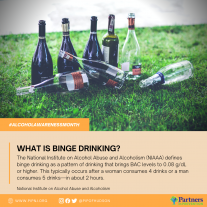
It is well known that drinking too much alcohol is harmful to one’s health. In fact, each year, more than 95,000 deaths occur in the United States from alcohol-related causes. That includes about 5,000 people under the age of 21 dying annually from alcohol-related traffic accidents, homicides, suicides, alcohol poisoning, and other injuries. Alcohol abuse also wages economic, personal, and health-related tolls on individuals. April is Alcohol Awareness Month, a good time to learn the facts and avoid the devastating results that alcohol misuse can bring.
Just the Facts
The following facts may help you make wise choices before and while consuming alcohol.
A standard drink in the United States contains roughly 14 grams of pure alcohol, which is found in the following equivalents:
- 12 ounces of beer (about 5 percent alcohol)
- 8 ounces of malt liquor (about 7 percent alcohol)
- 5 ounces of wine (about 12 percent alcohol)
- 5 ounces of 80 proof (40 percent alcohol content) distilled liquor or spirits
Drinking in moderation is considered up to one drink per day for women and up to two drinks per day for men of legal drinking age.
Alcohol should never be consumed under the following conditions:
- When under age 21
- While pregnant or trying to become pregnant
- When taking medications that interact with alcohol
- When planning to drive a vehicle or operating machinery
- When participating in activities that require skill, coordination, or alertness
- When recovering from alcohol use disorder or when unable to control the amount consumed
Binge drinking is a pattern of drinking that increases a person’s blood alcohol concentration (BAC) levels to 0.08 percent or higher, the point at which it is unsafe—and illegal—to drive. Binge drinking is the most common form of excessive drinking and is defined as:
- 4 or more drinks at one time for women

- 5 or more drinks at one time for men
Heavy drinking is defined as the following:
- More than 3 drinks on any given day for women
- More than 4 drinks on any given day for men
Short-Term Health Risks
Immediate risks from excessive alcohol consumption include:
- Injuries, such as from car accidents, falls, drownings, and burns
- Violence, including homicide, suicide, sexual assault
- Alcohol poisoning, which can lead to unconsciousness, coma, or even death
- Risky sexual behavior
- Miscarriage or stillbirth or fetal alcohol spectrum disorders (FASDs)
Long-Term Health Risks
Excessive drinking over a long period of time can lead to the following:
- High blood pressure, heart disease, stroke, liver disease, and digestive disorders
- Cancer of the breast, mouth, throat, liver, and colon
- Memory and learning disorders, including dementia
- Mental health problems, including depression and anxiety
- Social problems, including lost jobs, broken families, lost productivity
- Alcohol use disorders or dependency
A Number of Other Important Facts
- Men are two times as likely as women to be involved in fatal accidents due to overdrinking.
- 70 percent of 18-year-olds admit to drinking an alcoholic beverage at least once.
- 55.3 percent of high school seniors have used alcohol in the past year.
- About two-thirds of high school students who drink do so to the point of being intoxicated.
- 85.6 percent of all adults have drunk alcohol at some time in their lives.
- About 17 percent of men and 8 percent of women will become alcohol dependent in their lifetime.

Where to Find Help
Excessive drinking is a life-or-death matter. The Substance Abuse and Mental Health Services Administration (SAMHSA) offers a 24-hour-a-day national helpline that can be reached by dialing 1-800-662-HELP (4357).
The San Diego chapter of Alcoholics Anonymous (AA) is open to anyone who wants help with their drinking problem. Visit the AA website for information on AA’s 12-step program and meetings in the area, some of which are virtual and others, in person. Phone 619-265-8762 for help around the clock.
Sources: Centers for Disease Control and Prevention, Alcohol and Public Health, Alcohol Use and Your Health, https://www.cdc.gov/alcohol/fact-sheets/alcohol-use.htm; National Institute on Alcohol Abuse and Alcoholism (NIAAH), What Are the Different Drinking Levels?, https://www.rethinkingdrinking.niaaa.nih.gov/How-much-is-too-much/Is-your-drinking-pattern-risky/Drinking-Levels.aspx; NIAAH, What’s a “Standard Drink”?, https://www.rethinkingdrinking.niaaa.nih.gov/how-much-is-too-much/what-counts-as-a-drink/whats-a-standard-drink.aspx; Partners in Prevention, What Is Alcohol Awareness Month?, https://pipnj.org/aam2021/
Graphics: Can Stock Photo; https://pipnj.org/aam2021/, SAMHSA

